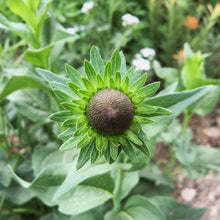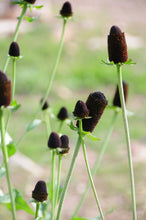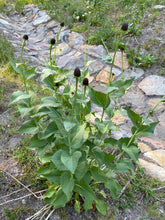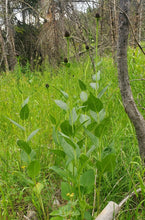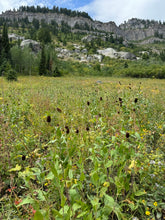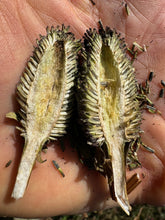
Rudbeckia occidentalis
Western coneflower, is one of the most unusual wildflowers with impressively tall, upright stems that can reach up to five feet without flopping over. It’s a prized find along seeps and meadows for hikers and pollinators alike. In spring, the plant emerges with dense clumps of dark green leaves, setting the stage for its striking, cone-shaped buds to form. By summer, the plant explodes with dramatic, purplish-black cones, each packed with hundreds of teensy “disc florets”. The spent flower heads dry into spiky seed heads. If left in place, they will persist through the colder months, feeding songbirds and adding texture and visual interest to the garden.
- Plant type/canopy layer: deciduous, perennial, herbaceous plant
- Size at maturity: 36-60” tall; 24-36” wide
- Light requirements: full sun, part sun/part shade
- Moisture requirements: moist to wet soil
- Bloom time: June-September
- Growth rate/ease: medium growth rate, moderately difficult to grow
- Wildlife support: flowers attract and support adult bees, butterflies and other insect pollinators; seeds are eaten by songbirds
- Native habitat/range: thieves in meadows and seeps, wetlands, riparian areas, at pond edges, moist forest openings and even roadside ditches, at altitudes of 500-2800 meters, from Washington to northern California and east to Wyoming and northeastern Montana. Portland Plant List - no.
- Special features & uses: deer resistant; medicinally it has a long history of traditional use for its anti-inflammatory and antimicrobial properties, which have been confirmed through a number of scientific studies, the fresh leaves can be rubbed directly on aching joints and a decoction of the sap can be used to treat and speed up the healing of burns; landscape uses include raingardens, bioswales and pond edges
Gardening with Western Coneflower: Western coneflower is a striking addition to the home garden, offering vertical interest and bold color to prairies, meadows, or mixed borders. It thrives in full sun, but can tolerate light shade, and prefers moist, well-drained soil. It can handle drying out between waterings, but will need supplemental water during the summer months in most gardens, especially while becoming established in its first two summers. When planted in drifts, you’ll enjoy scores of bumblebees, butterflies and other insect pollinators foraging on the flowers. Deadheading will prolong its incredible blooms into fall.
Photo Credit 1 (cone symmetry): © Anders Hastings, some rights reserved (CC-BY)
Photo Credit 2 (many flowers): © Vince Smith, some rights reserved (CC-BY)
Photo Credit 3 (flowering habit): © Matt Berger, some rights reserved (CC-BY)
Photo Credit 4 (flowering tall): © Laura Gaudette, some rights reserved (CC-BY)
Photo Credits 5 & 6 (fall look, seeds): © Matt Lavin, some rights reserved (CC-BY)






